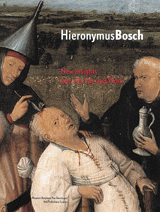
Vervoort 2001
“The Pestilent Toad. The Significance of the Toad in the Works of Bosch” (Renilde Vervoort) 2001
[in: Jos Koldeweij, Bernard Vermet and Barbera van Kooij (eds.), Hieronymus Bosch. New Insights Into His Life and Work. Museum Boijmans Van Beuningen-NAi Publishers-Ludion, Rotterdam, 2001, pp. 144-151]
It is not always clear whether Bosch depicted a frog or a toad, but in the Middle Ages the toad was considered to be a kind of frog. It is beyond any doubt, though, that Bosch’s toads have to be interpreted in a negative way: the animal was associated with the devil, with purgatory, with hell, sins, death, witchcraft and jews. In this Bosch did not differ from his contemporaries because in the Middle Ages and later still all kinds of negative features were attributed to toads.
Toads already had a negative image in ancient Roman times and in the Bible. Vervoort then analyses the toad’s negative connotations in the Middle Ages and for each connotation she gives some striking examples in Bosch’s works, without claiming to be exhaustive.
Vervoort’s contribution offers a good deal of interesting information about the toad’s symbolism, but this material is presented in a rather off-hand way and is only derived from secundary sources. Furthermore frogs and toads are viewed as one and the same species, based on the argument that in the Middle Ages toads were considered to be a kind of frog. The question whether this is also true for Bosch’s paintings needs further research.
[explicit]